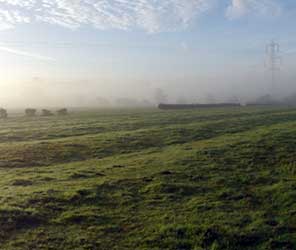Enclosure was the process of re-allocating the ownership of land. In England and Wales most enclosure was carried out during the 18th and early 19th centuries by Act of Parliament (Parliamentary Enclosure). There was a separate Act for each village, and it could be requested if the majority of the landowners of the village concerned were in favour.
However, some land had been already been enclosed in the preceding centuries, some with and some without local agreement: these enclosures were not always legal and could be the subject of protracted litigation (as happened in Thurcaston).
Before Enclosure

Ridge and furrow © Peter J Smith 2017
The system of narrow strips meant that the pattern of ploughing was the same each year. As soil was heaped into the centre, permanent ridges and furrows developed which can still be seen in places today.
Villages would have areas of common land in addition to the open fields. Certain villagers had the right to graze animals on the common land and on the open fields once the crops had been harvested.
Why Enclose?
Larger landowners wanted to consolidate their holdings into individual, enclosed fields. This meant that they could convert the arable land into more profitable pasture, or introduce new more efficient ways of growing crops for sale to the increasing urban populations.
The Parliamentary Enclosure Process
Commissioners and surveyors were appointed to undertake the process of re-allocating the total land available in a village in proportion to the area owned pre-enclosure. They had to assess the claims made by each landowner.
Before the land was divided between claimants, some was allocated for two purposes:
- roads and footpaths: the new routes would often follow established ones, but new roads were created where necessary.
- the enclosure system also involved the abolition of annual tithes payable by landowners to the Church. The commissioners awarded land to the Church to compensate for this loss of income.
The commissioners recorded their decisions in an Enclosure Award document which was accompanied by a map. Sadly, the maps (including those for Cropston and Thurcaston) have often been lost.
After Enclosure - The “Traditional” English Landscape
Landowners enclosed their new fields, often with hawthorn hedges to create the patchwork appearance which we consider traditional.